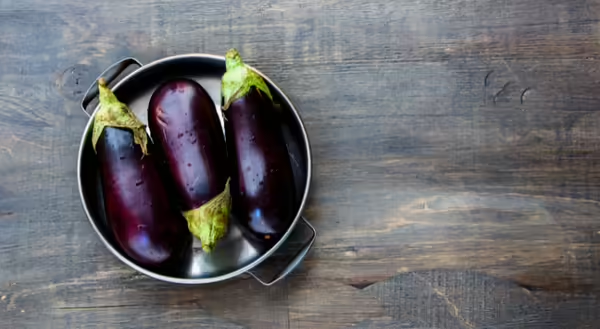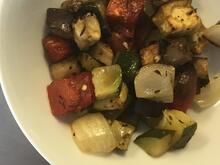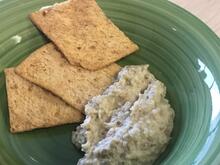
When writing about specific fruits and veggies, I like to look at recipes with that food. I know how I'd use eggplant, but how do others use it? It seems like eggplant pairs endlessly with so many flavors across so many cultures. While eggplant can be the center of the dish, it can also compliment other ingredients. It's definitely worth adding to your next recipe!
Nutritionally, one cup of cubed eggplant contains around 20 calories, 5g carbohydrates, and 2g fiber, and contains vitamins and minerals, including vitamins A and K, magnesium, potassium, and folate. Eggplant is not a significant source of fat, protein, or sodium.
- Types: The recipes in this post are written for the dark-purple, oval-shaped eggplants with white flesh that are common in most grocery stores in the U.S. But you can buy and grow many different shapes and colors of eggplant. University of Florida Extension shows pictures of some fun-looking heirloom eggplant varieties in their handout.
- Buy: Look for eggplants that are firm and heavy with a bright, glossy, smooth skin. Avoid eggplant that are soft or mushy. The older an eggplant is, the more bitter flavors can be present.
- Price: Eggplant may be sold by dollars per pound, so a smaller eggplant would cost less than a bigger eggplant.
- Store: Refrigerate unwashed eggplant for up to one week. Like other produce, pre-washing and then storing fruits and vegetables tends to shorten their storage time.
- Prepare:
- Wash eggplants before cutting. Cut off the top end near the stem and prepare as described in the recipe. Some recipes may leave the skin on or peel it off.
- Eggplant flesh can start to turn brown once cut. Cooking will prevent this, but if storing extra uncooked eggplant to use for a future recipe, be aware this browning may happen. It is the effect of oxygen, similar to how apples and avocados turns brown once cut. It is safe to eat this way, but cut away the brown areas if it's bothersome.
- Some recipes call for cut eggplant to be salted to remove some water. With less water, the eggplant is firmer and ideal for recipes where a more "meaty" texture is desired, such as in grilling or baking.
- Preserve: While there are no USDA or Extension tested recipes for canning eggplant, read more about freezing and drying eggplant from the National Center for Home Food Preservation.
- Eat: Enjoy eggplant in appetizers like the Pizza Snacks and Eggplant Dip recipe in this post. Add eggplant as a vegetable side dish with protein and starches or incorporated into recipes like eggplant parmesan, curries, and stir-fries.
Eggplant Pizza Snacks | Print recipe
serves 8
Roasted Ratatouille | Print recipe
Serves 6
Eggplant Dip | Print recipe
Serves 6
Resources:
-
Colorado State University, Simple Eggplant Recipes and Cooking Tips, 2020
-
Iowa State University Extension and Outreach, Spend Smart, Eat Smart, Eggplant, N/D
-
Iowa State University Extension and Outreach, The Not So “Bitter” Truth About Eggplant, 2020
-
Louisiana State University Ag Center, Why Did the Eggplant Turn Brown?, 2019
-
Michigan State University Extension, Eggplant: It’s purple, healthy and easy to prepare, 2013
-
Ohio State University Extension, Selecting, Storing, and Serving Ohio Eggplant, 2021
-
Purdue Extension, FoodLink, Eggplant, N/D
-
South Dakota State Extension, Pick it! Try it! Like it! Eggplant, 2022
- United States Department of Agriculture, FoodData Central
-
University of Maine Cooperative Extension, Vegetables and Fruits for Health: Eggplant, 2009
-
University of Nebraska-Lincoln, Eggplant, N/D
Post originally published in 2018; content updated in 2022.
Healthy Eats and Repeat
How much difference is there between canned and frozen foods? How should you cook venison? When is the best time to buy avocados? Get answers to these questions as well as other tips, tutorials and recipes for common kitchen foods and items with University of Illinois Extension Nutrition & Wellness Educator Caitlin Mellendorf. Build your best life. Trust Extension to help.
Caitlin Mellendorf is an Illinois Extension Nutrition and Wellness Educator serving DeWitt, Macon and Piatt Counties in Central Illinois. She is a Registered Dietitian and her work focuses on helping community members gain the knowledge, skills and tools to live healthier, more nutritious lifestyles. This includes providing programs and answering questions about heart health, diabetes, food safety, food preservation, grocery shopping and cooking. You can reach Caitlin by email at chuth2@illinois.edu or call 217.877.6042.


